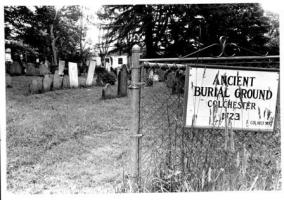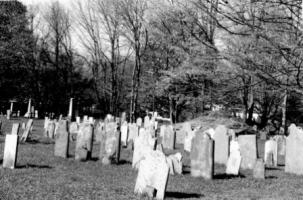Ancient Burial Grounds


The earliest mention of a cemetery located behind the old Bacon Academy occurs in October, 1707. Capt. Samuel Gilbert was granted “the Liberty to fence the Burying yard, it being two acres, and to have the grass as feed that is on it so long as he maintains the Fence sufficient.” The burying ground was a small cleared space with only a few scattered graves. The trees from the area have been hewed into timbers for the church. By December, 1723. better facilities for burying the dead were needed, “to Fence and clear so much of the Burying yard as may be convenient.” This was delayed for seven years, for in 1731 the town granted the right to the standing grass on the cemetery grounds to Capt. Joseph Wright. Capt. Wright agreed that he would erect a stone wall across the cemetery front and fence the sides and rear with posts and rails.
We may now visualize these grounds as they may have looked in 1731 with the church and school buildings standing there, including a section cleared and fenced for a burying yard. Trees and staddles surrounded the meetinghouse for a distance of at least fifteen feet and there were rods for the convenience of hitching horses. The grounds occupied the entire corner formed by Linwood Ave. and New London Road (Routes 16 and 85) and extended as far down this road as the south side of the bounds of the old cemetery.
Many of the early settlers of Colchester are buried in the ancient burial grounds. Among the most prominent were: Rev. John Bulkeley – first minister of the first church in Colchester; John R. Watrous – a surgeon in the Revolutionary War; and Pierpont Bacon – original donor ($35,000) for the building of Bacon Academy.
The above is an excerpt from 300 Years of Colchester, A Commemorative Album, published during the 300th Anniversary celebration of Colchester’s history.
The Colchester Historical Society has an exhibit in their museum, located next to Cragin Memorial Library, which provides detailed information about the cemetery and the “Bulkeley Tomb” which was widely publicized when an archeological dig was conducted a few years ago. This exhibit provides more background and information on the site.

